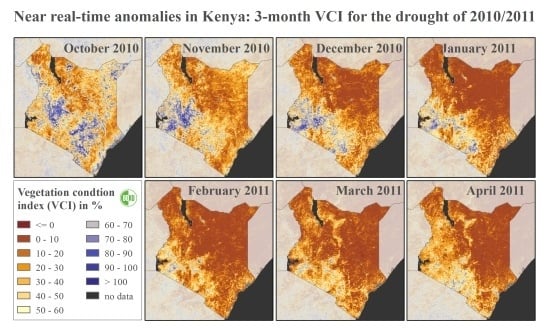Operational Drought Monitoring in Kenya Using MODIS NDVI Time Series
Abstract
:1. Introduction
2. Material and Methods
2.1. Study Area
2.2. MODIS Data Processing at BOKU
2.2.1. Overview of the Operational Processing Chain
2.2.2. MODIS Data Acquisition and Preparation
2.2.3. NRT Filtering
- Offline smoothing (done only once): Smoothing applies in a post hoc sense, where there is a need to interpolate past events in a time series. By definition, smoothing estimates a state based on data from both previous and later times.
- NRT filtering (repeated every week): Filtering is relevant in an online learning sense, in which current conditions are to be estimated by the currently available data. Filtering, therefore, involves calculating the estimate of a certain state based on a partial sequence of inputs.
2.2.4. Uncertainty Modeling
2.3. Drought Indicator Calculation
2.4. FEWS NET Data Preparation for Comparison
- cropping and resampling to the BOKU grid (see Figure 1b);
- calculation of pentadal statistics (minimum, maximum) from the NDVI for each pixel and the period of 2003 to 2012;
- calculation of pentadal VCI images using the derived statistics (Equation (1));
- temporal aggregation of VCI images (1 and 3 months) by averaging 6 and 18 pentades, respectively; and
- spatial aggregation by averaging according to administrative units (e.g., ASAL counties of Kenya; see Figure 1b).
3. Results and Discussion
3.1. Illustration of Filtering Performance & Example Products from BOKU
3.1.1. Filtered NDVI Data and Modeled Uncertainty
- Filtered values (colored lines) become smoother and come closer to the smoothed values (black dots) with increasing consolidation period.
- The modeled uncertainties are of variable widths but generally shrink with increasing consolidation period.
- Occurrences of large differences between filtered and smoothed NDVI values are mostly associated with larger uncertainty ranges.
- In most cases, smoothed values are found within the predicted uncertainty range.
3.1.2. Calculated Drought Indicators
3.2. Comparison of FEWS NET and BOKU Drought Indicators
3.2.1. Overall Agreement between BOKU and FEWS NET Data
3.2.2. Seasonal Differences between BOKU and FEWS NET Data
3.2.3. Annual Differences between FEWS NET and BOKU Data
3.2.4. Spatial Patterns of Agreement/Disagreement between FEWS NET and BOKU Data
4. Conclusions
Acknowledgments
Author Contributions
Conflicts of Interest
Appendix
1. Web Interfaces

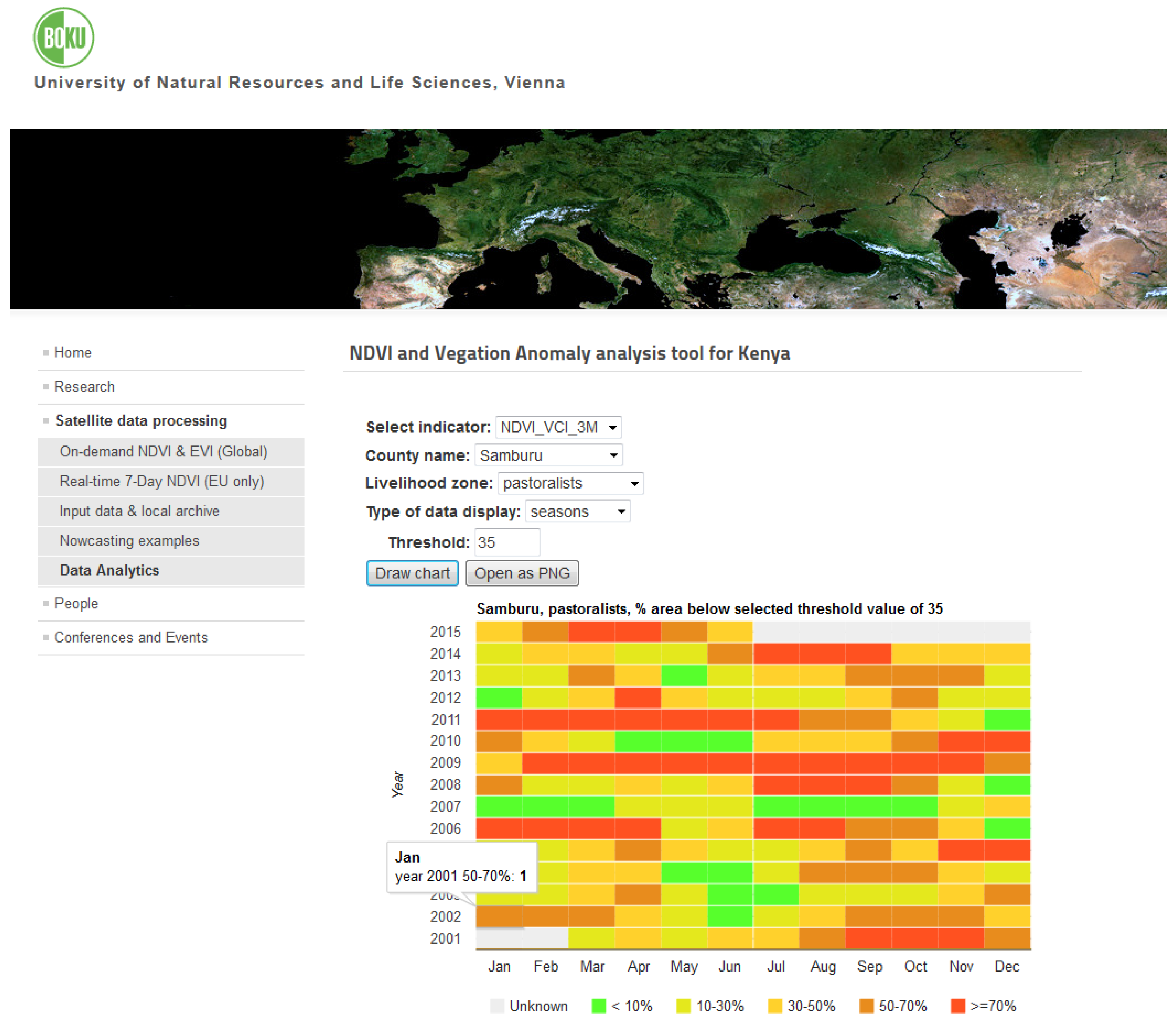
References
- Heim, R.R., Jr. A review of twentieth-century drought indices used in the United States. B Am. Meteorol. Soc. 2002, 83, 1149–1165. [Google Scholar]
- Anderson, W.B.; Zaitchik, B.F.; Hain, C.R.; Anderson, M.C.; Yilmaz, M.T.; Mecikalski, J.; Schultz, L. Towards an integrated soil moisture drought monitor for East Africa. Hydrol. Earth. Syst. Sci. 2012, 16, 2893–2913. [Google Scholar] [CrossRef]
- Wilhite, D.; Buchanan-Smith, M. Drought as a natural hazard: Understanding the natural and social context. In Drought and Water Crises: Science, Technology, and Management Issues; Wilhite, D., Ed.; CRC Press: Boca Raton, FL, USA, 2005; pp. 3–29. [Google Scholar]
- Below, R.; Grover-Kopec, E.; Dilley, M. Documenting drought-related disasters: A global reassessment. J. Environ. Dev. 2007, 16, 328–344. [Google Scholar] [CrossRef]
- Vicente-Serrano, S.M.; Beguería, S.; Gimeno, L.; Eklundh, L.; Giuliani, G.; Weston, D.; Kenawy, A.E.; López-Moreno, J.I.; Nieto, R.; Ayenew, T.; et al. Challenges for drought mitigation in Africa: The potential use of geospatial data and drought information systems. Appl. Geogr. 2012, 34, 471–486. [Google Scholar] [CrossRef] [Green Version]
- Mishra, A.K.; Singh, V.P. A review of drought concepts. J. Hydrol. 2010, 391, 202–216. [Google Scholar] [CrossRef]
- Brown, M.; Funk, C.; Galu, U.; Choularton, R. Earlier famine warning possible using remote sensing and models. EOS 2007, 88, 381–398. [Google Scholar] [CrossRef]
- Brown, M. Famine Early Warning Systems and Remote Sensing Data; Springer: Oakton, IL, USA, 2008. [Google Scholar]
- Vrieling, A.; Meroni, M.; Shee, A.; Mude, A.G.; Woodard, J.; de Bie, C.K.; Rembold, F. Historical extension of operational NDVI products for livestock insurance in Kenya. Int. J. Appl. Earth Obs. Geoinf. 2014, 28, 238–251. [Google Scholar] [CrossRef]
- Rembold, F.; Atzberger, C.; Savin, I.; Rojas, O. Using low resolution satellite imagery for yield prediction and yield anomaly detection. Remote Sens. 2013, 5, 1704–1733. [Google Scholar] [CrossRef] [Green Version]
- Thenkabail, P.S. Remote Sensing of Water Resources, Disasters, and Urban Studies; CRC Press: Boca Raton, FL, USA, 2015. [Google Scholar]
- Kogan, F.; Guo, W. Agricultural drought detection and monitoring using vegetation health methods. In Remote Sensing of Water Resources, Disasters, and Urban Studies; Thenkabail, P.S., Ed.; CRC Press: Boca Raton, FL, USA, 2015; pp. 339–348. [Google Scholar]
- Rembold, F.; Meroni, M.; Rojas, O.; Atzberger, C.; Ham, F.; Fillol, E. Agricultural drought monitoring using space-derived vegetation and biophysical products. In Remote Sensing of Water Resources, Disasters, and Urban Studies; Thenkabail, P.S., Ed.; CRC Press: Boca Raton, FL, USA, 2015; pp. 349–366. [Google Scholar]
- Wardlow, B.; Anderson, M.; Tadesse, T.; Hain, C.; Crow, W.; Rodell, M. Remote sensing of drought: Emergence of a satellite-based monitoring toolkit for the United States. In Remote Sensing of Water Resources, Disasters, and Urban Studies; Thenkabail, P.S., Ed.; CRC Press: Boca Raton, FL, USA, 2015; pp. 367–400. [Google Scholar]
- Rhee, J.; Im, J.; Park, S. Regional drought monitoring based on multisensor remote sensing. In Remote Sensing of Water Resources, Disasters, and Urban Studies; Thenkabail, P.S., Ed.; CRC Press: Boca Raton, FL, USA, 2015; pp. 401–416. [Google Scholar]
- Senay, G.; Velpuri, N.; Bohms, S.; Budde, M.; Young, C.; Rowland, J.; Verdin, J. Drought monitoring and assessment: Remote sensing and modeling approaches for the Famine Early Warning Systems Network. In Hydro-Meteorological Hazards, Risks and Disasters; Paron, P., Di Baldassarre, G., Shroder, J.F., Eds.; Elsevier: Boston, MA, USA, 2015; pp. 233–262. [Google Scholar]
- Svoboda, M. An introduction to the drought monitor. Drought Network News 2000, 12, 80. [Google Scholar]
- Sivakumar, M.; Motha, R.; Wilhite, D.; Qu, J. (Eds.) Towards a compendium on national drought policy. In Proceedings of the Expert Meeting on the Preparation of a Compendium on National Drought Policy, Washington, DC, USA, 14–15 July 2011; World Meteorological Organization: Geneva, Switzerland, 2011.
- Vrieling, A.; Meroni, M.; Mude, A.; Chantarat, S.; Ummenhofer, C.; de Bie, K. Early assessment of seasonal forage availability for mitigating the impact of drought on East African pastoralists. Remote Sens. Environ. 2016, 174, 44–55. [Google Scholar] [CrossRef]
- Tadesse, T.; Haile, M.; Senay, G.; Wardlow, B.D.; Knutson, C.L. The need for integration of drought monitoring tools for proactive food security management in sub-Saharan Africa. Nat. Resour. Forum 2008, 32, 265–279. [Google Scholar] [CrossRef]
- Tadesse, T.; Wardlow, B.D.; Hayes, M.J.; Svoboda, M.D.; Brown, J.F. The vegetation outlook (VegOut): A new method for predicting vegetation seasonal greenness. GISci. Remote Sens. 2010, 47, 25–52. [Google Scholar] [CrossRef]
- Sheffield, J.; Wood, E.F.; Chaney, N.; Guan, K.; Sadri, S.; Yuan, X.; Olang, L.; Amani, A.; Ali, A.; Demuth, S.; et al. A drought monitoring and forecasting system for sub-Sahara African water resources and food security. Bull. Am. Meteor. Soc. 2014, 95, 861–882. [Google Scholar] [CrossRef]
- Rojas, O.; Vrieling, A.; Rembold, F. Assessing drought probability for agricultural areas in Africa with coarse resolution remote sensing imagery. Remote Sens. Environ. 2011, 115, 343–352. [Google Scholar] [CrossRef]
- Hird, J.; McDermid, G. Noise reduction of NDVI time series: An empirical comparison of selected techniques. Remote Sens. Environ. 2009, 113, 248–258. [Google Scholar] [CrossRef]
- Atzberger, C.; Eilers, P.H.C. Evaluating the effectiveness of smoothing algorithms in the absence of ground reference measurements. Int. J. Remote Sens. 2011, 32, 3689–3709. [Google Scholar] [CrossRef]
- Atkinson, P.M.; Jeganathan, C.; Dash, J.; Atzberger, C. Intercomparison of four models for smoothing satellite sensor time-series data to estimate vegetation phenology. Remote Sens. Environ. 2012, 123, 400–417. [Google Scholar] [CrossRef]
- Geng, L.; Ma, M.; Wang, X.; Yu, W.; Jia, S.; Wang, H. Comparison of eight techniques for reconstructing multi-satellite sensor time-series NDVI data sets in the Heihe River basin, China. Remote Sens. 2014, 6, 2024–2049. [Google Scholar] [CrossRef]
- Kandasamy, S.; Fernandes, R. An approach for evaluating the impact of gaps and measurement errors on satellite land surface phenology algorithms: Application to 20 year NOAA AVHRR data over Canada. Remote Sens. Environ. 2015, 164, 114–129. [Google Scholar] [CrossRef]
- Shao, Y.; Lunetta, R.S.; Wheeler, B.; Iiames, J.S.; Campbell, J.B. An evaluation of time-series smoothing algorithms for land-cover classifications using MODIS-NDVI multi-temporal data. Remote Sens. Environ. 2016, 174, 258–265. [Google Scholar] [CrossRef]
- Eilers, P.H.C. A perfect smoother. Anal. Chem. 2003, 75, 3631–3636. [Google Scholar] [CrossRef] [PubMed]
- Eilers, P.H.C.; Marx, B.D. Splines, knots, and penalties. Wiley Interdiscip. Rev. Comput. Stat. 2010, 2, 637–653. [Google Scholar] [CrossRef]
- Atzberger, C.; Eilers, P.H.C. A time series for monitoring vegetation activity and phenology at 10-daily time steps covering large parts of South America. Int. J. Digit. Earth 2011, 4, 365–386. [Google Scholar] [CrossRef]
- Atzberger, C.; Klisch, A.; Mattiuzzi, M.; Vuolo, F. Phenological metrics derived over the European continent from NDVI3g data and MODIS time series. Remote Sens. 2014, 6, 257–284. [Google Scholar] [CrossRef]
- Maidment, R.I.; Grimes, D.; Allan, R.P.; Tarnavsky, E.; Stringer, M.; Hewison, T.; Roebeling, R.; Black, E. The 30 years TAMSAT African rainfall climatology and time series (TARCAT) data set. J. Geophys. Res. A 2014, 119, 10619–10644. [Google Scholar] [CrossRef]
- Tarnavsky, E.; Grimes, D.; Maidment, R.; Black, E.; Allan, R.P.; Stringer, M. Extension of the TAMSAT satellite-based rainfall monitoring over Africa and from 1983 to present. J. Appl. Meteorol. 2014, 53, 2805–2822. [Google Scholar] [CrossRef]
- Brown, M. Biophysical remote sensing and climate data in famine early warning systems. Geogr. Compass 2009, 3, 1381–1407. [Google Scholar] [CrossRef]
- Meroni, M.; Verstraete, M.M.; Rembold, F.; Urbano, F.; Kayitakire, F. A phenology-based method to derive biomass production anomalies for food security monitoring in the Horn of Africa. Int. J. Remote Sens. 2014, 35, 2472–2492. [Google Scholar] [CrossRef]
- Kenya GIS Data. World Resources Institute (WRI). Available online: http://www.wri.org/resources/data-sets/kenya-gis-data (accessed on 26 February 2016).
- TAMSAT (Tropical Applications of Meteorology Using SATellite Data and Ground-Based Observations). University of Reading. Available online: http://www.met.reading.ac.uk/~tamsat/data/ (accessed on 26 February 2016).
- Solano, R.; Didan, K.; Jacobson, A.; Huete, A. MODIS Vegetation Index User’s Guide (MOD13 Series), Version 2.00, May 2010 (Collection 5). Vegetation Index and Phenology Lab, The University of Arizona. 2010. Available online: http://www.ctahr.hawaii.edu/grem/modis-ug.pdf (accessed on 9 March 2016).
- Mattiuzzi, M.; Verbesselt, J.; Hengl, T.; Klisch, A.; Evans, B.; Lobo, A. MODIS: MODIS download and processing package. In Processing Functionalities for (Multi-Temporal) MODIS Grid Data. First International Workshop on “Temporal Analysis of Satellite Images”, Mykonos Island, Greece, 23–25 May 2012.
- Vuolo, F.; Atzberger, C. Exploiting the classification performance of support vector machines with multi-temporal Moderate-Resolution Imaging Spectroradiometer (MODIS) data in areas of agreement and disagreement of existing land cover products. Remote Sens. 2012, 4, 3143–3167. [Google Scholar] [CrossRef]
- Sedano, F.; Kempeneers, P.; Hurtt, G. A Kalman filter-based method to generate continuous time series of medium-resolution NDVI images. Remote Sens. 2014, 6, 12381–12408. [Google Scholar] [CrossRef]
- Beck, P.S.A.; Atzberger, C.; Høgda, K.A.; Johansen, B.; Skidmore, A.K. Improved monitoring of vegetation dynamics at very high latitudes: A new method using MODIS NDVI. Remote Sens. Environ. 2006, 100, 321–334. [Google Scholar] [CrossRef]
- Brown, M.; Lary, D.; Vrieling, A.; Stathakis, D.; Mussa, H. Neural networks as a tool for constructing continuous NDVI time series from AVHRR and MODIS. Int. J. Remote Sens. 2008, 29, 7141–7158. [Google Scholar] [CrossRef]
- Bradley, B.; Jacob, R.; Hermance, W. A curve fitting procedure to derive inter-annual phenologies from time series of noisy satellite NDVI data. Remote Sens. Environ. 2007, 106, 137–145. [Google Scholar] [CrossRef]
- Chen, J.; Jönsson, P.; Tamura, M.; Gu, Z. A simple method for reconstructing a high-quality NDVI time-series data set based on the Savitzky–Golay filter. Remote Sens. Environ. 2004, 91, 332–344. [Google Scholar] [CrossRef]
- Viovy, N.; Arino, O.; Belward, A. The Best Index Slope Extraction (BISE): A method for reducing noise in NDVI time-series. Int. J. Remote Sens. 1992, 13, 1585–1590. [Google Scholar] [CrossRef]
- Kogan, F.; Gitelson, A.; Zakarin, E.; Spivak, L.; Lebed, L. AVHRR-based spectral vegetation index for quantitative assessment of vegetation state and productivity: Calibration and validation. Photogramm. Eng. Remote Sens. 2003, 69, 809–906. [Google Scholar] [CrossRef]
- Rembold, F.; Meroni, M.; Urbano, F.; Royer, A.; Atzberger, C.; Lemoine, G.; Eerens, H.; Haesen, D. Remote sensing time series analysis for crop monitoring with the SPIRITS software: New functionalities and use examples. Front. Environ. Sci. 2015, 3. [Google Scholar] [CrossRef]
- Web-tools for Vegetation Anomaly Analysis. BOKU. Available online: http://ivfl-geomap.boku.ac.at/demo_WG/kenya/, http://ivfl-info.boku.ac.at/index.php/eo-data-processing/data-analytics (accessed on 26 February 2016).
- USGS. eMODIS Africa Product Guide Version 1.0, 2011; USGS EROS Data Center: Sioux Falls, SD, USA, 2011. [Google Scholar]
- USGS. eMODIS TERRA Normalized Difference Vegetation Index (NDVI). 2013. Available online: http://earlywarning.usgs.gov/fews/product/116 (accessed on 16 March 2016).
- Colditz, R.R.; Conrad, C.; Wehrmann, T.; Schmidt, M.; Dech, S. Analysis of the quality of collection 4 and 5 vegetation index time series from MODIS. In Proceedings of the ISPRS 5th International Symposium Spatial Data Quality, Enschede, The Netherlands, 13–15 June 2007; Volume XXXVI-2/C43.
- KFSSG. Kenya Long Rains Assessment Report 2009. Technical Report, Kenya Food Security Steering Group (KFSSG). 2009. Available online: http://documents.wfp.org/stellent/groups/public/documents/ena/wfp208056.pdf?iframe (accessed on 9 March 2016).
- KFSSG. Kenya Long Rains Assessment Report 2011. Technical Report, Kenya Food Security Steering Group (KFSSG). 2011. Available online: http://documents.wfp.org/stellent/groups/public/documents/ena/wfp240180.pdf (accessed on 9 March 2016).
- KFSSG. Kenya Long Rains Assessment Report 2014. Technical Report, Kenya Food Security Steering Group (KFSSG). 2014. Available online: http://www.ipcinfo.org/fileadmin/user_upload/ipcinfo/docs/2014%20Kenya%20LRA%20National%20Report.pdf (accessed on 9 March 2016).
- KFSSG. Kenya Long Rains Assessment Report 2006. Technical Report, Kenya Food Security Steering Group (KFSSG). 2006. Available online: http://reliefweb.int/sites/reliefweb.int/files/resources/F63B1A92E605B2E4C1257230004B666F-govt-ken-12sep.pdf (accessed on 9 March 2016).
- KFSSG. Kenya Long Rains Assessment Report 2010. Technical Report, Kenya Food Security Steering Group (KFSSG). 2010. Available online: http://www.fao.org/fileadmin/user_upload/drought/docs/Kenya_2010_LRA%20Report.pdf (accessed on 9 March 2016).
- KFSSG. Kenya Long Rains Assessment Report 2013. Technical Report, Kenya Food Security Steering Group (KFSSG). 2013. Available online: https://www.humanitarianresponse.info/system/files/documents/files/LRA%202013_National%20Report_Final.pdf (accessed on 9 March 2016).
- KFSSG. Kenya Short Rains Assessment Report 2005. Technical Report, Kenya Food Security Steering Group (KFSSG). 2006. Available online: http://documents.wfp.org/stellent/groups/public/documents/ena/wfp087348.pdf?iframe (accessed on 9 March 2016).
- KFSSG. Kenya Short Rains Assessment Report 2010. Technical Report, Kenya Food Security Steering Group (KFSSG). 2011. Available online: http://documents.wfp.org/stellent/groups/public/documents/ena/wfp241326.pdf?iframe (accessed on 9 March 2016).
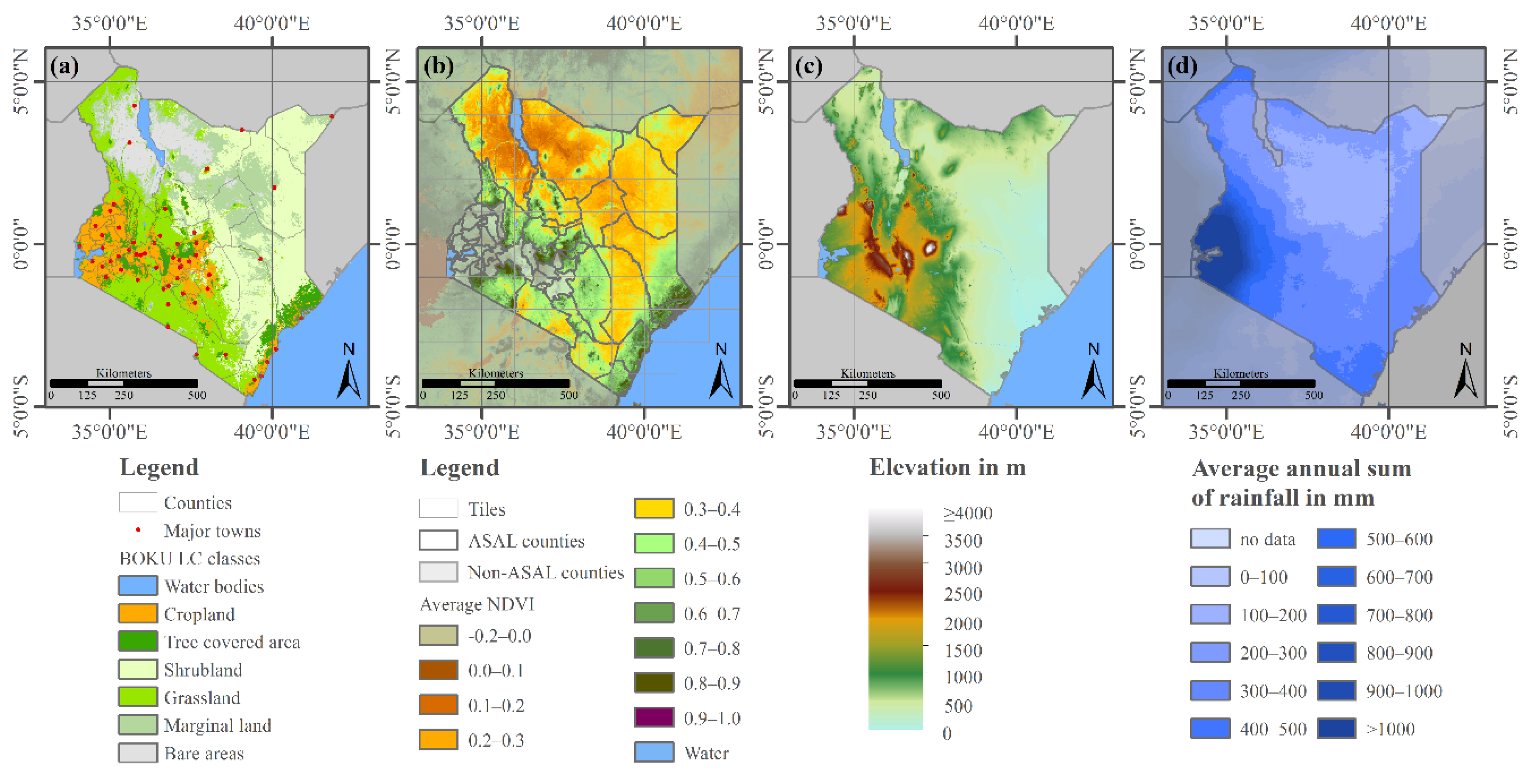

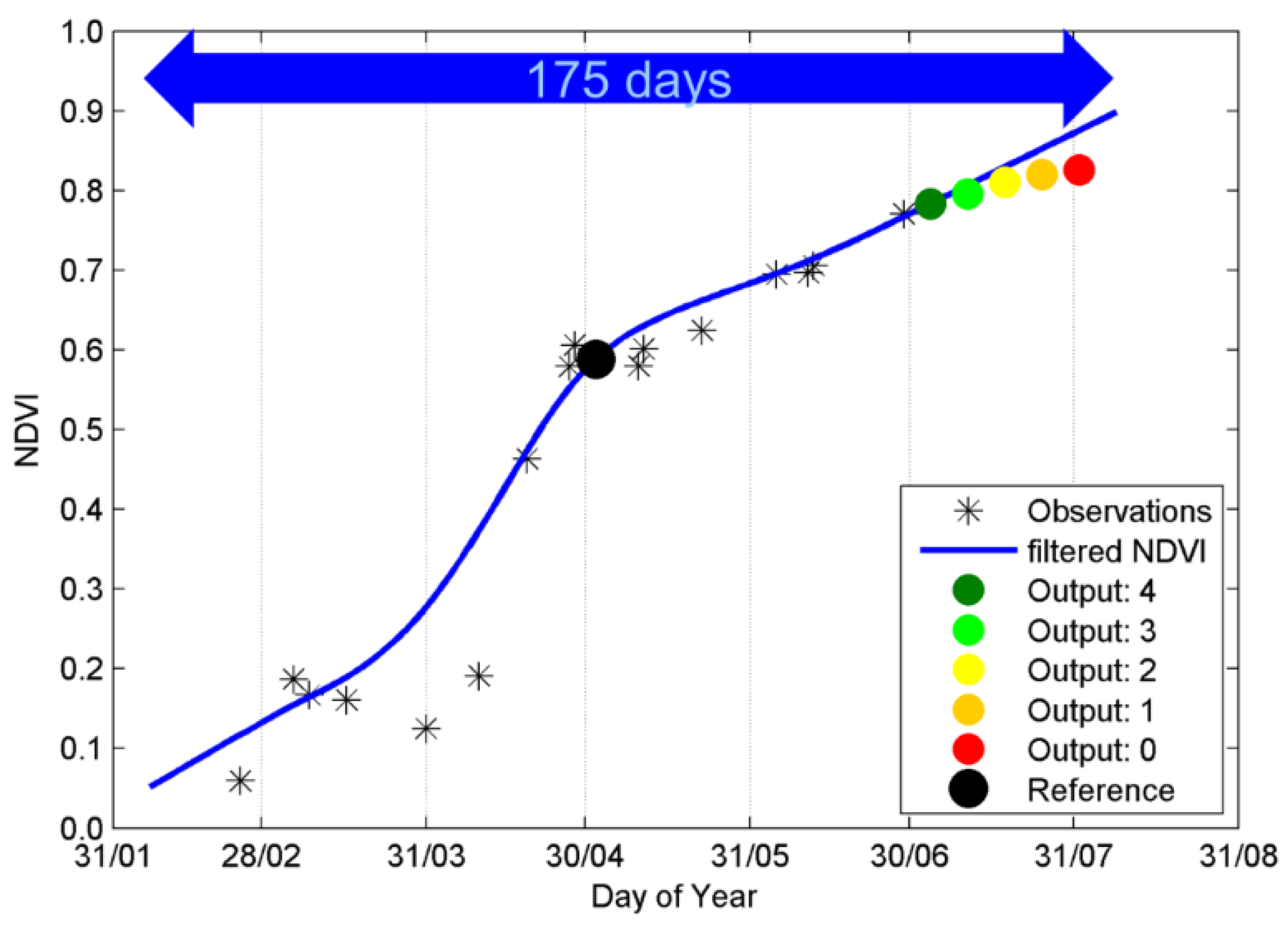
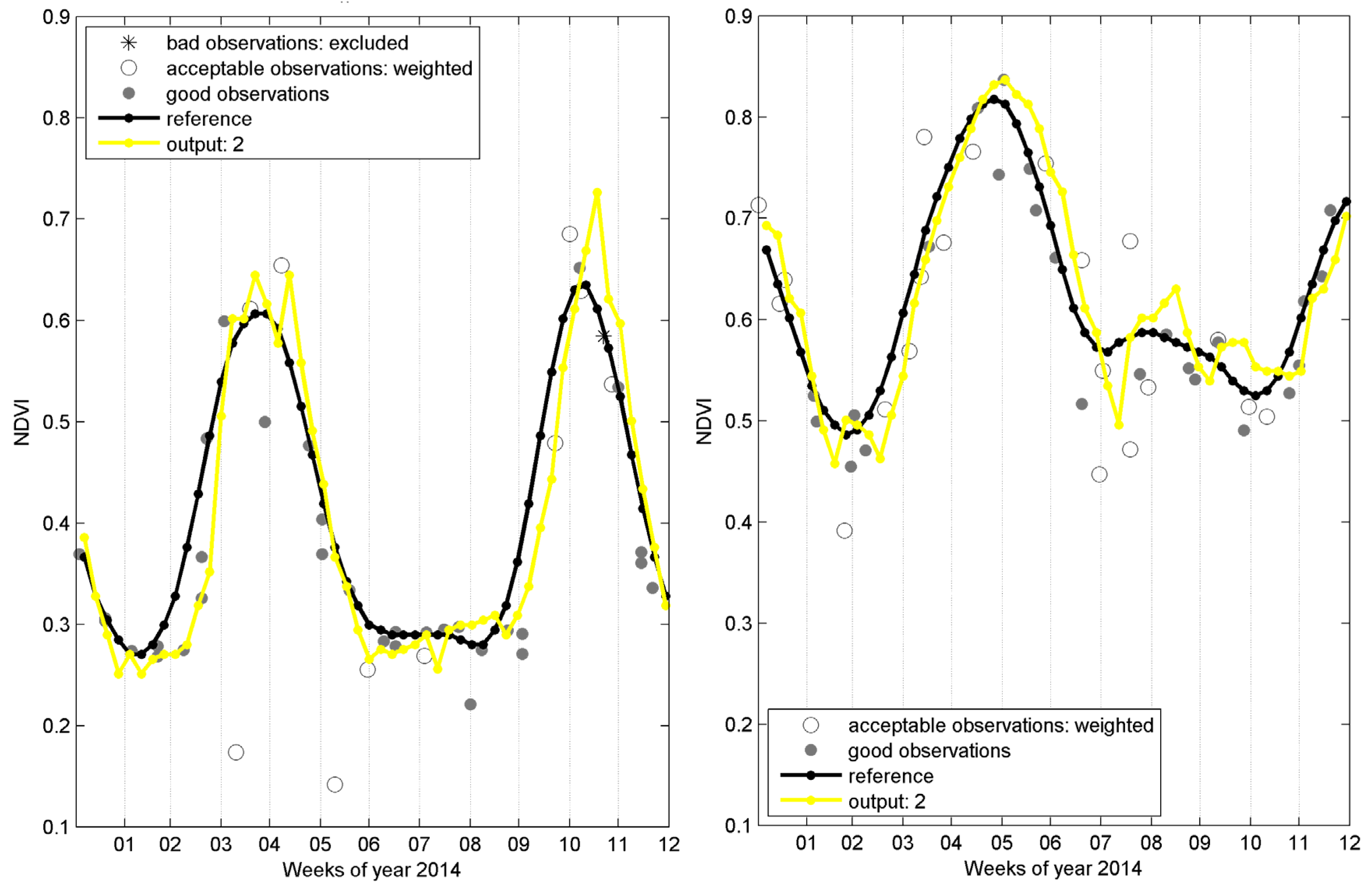
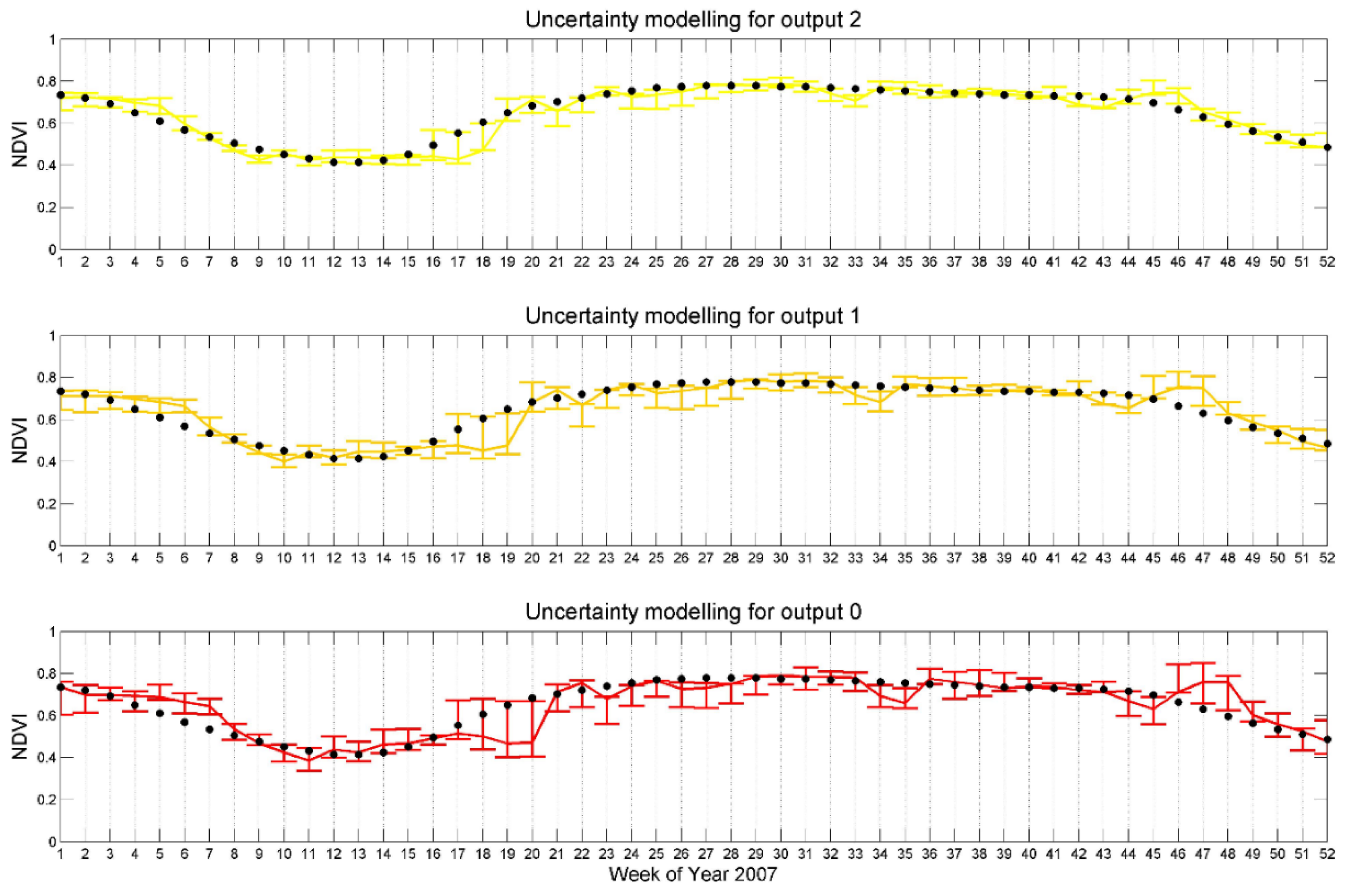

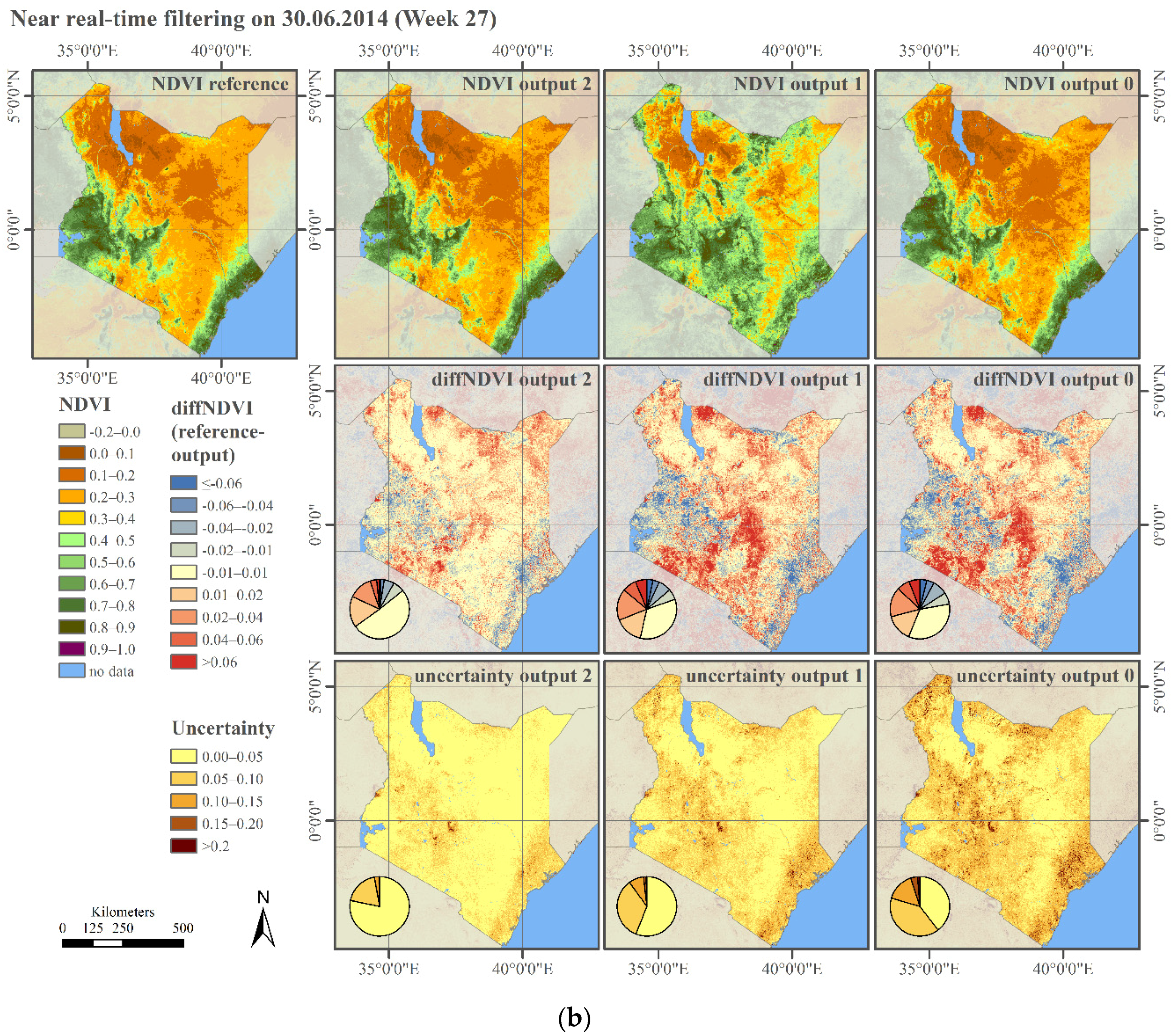
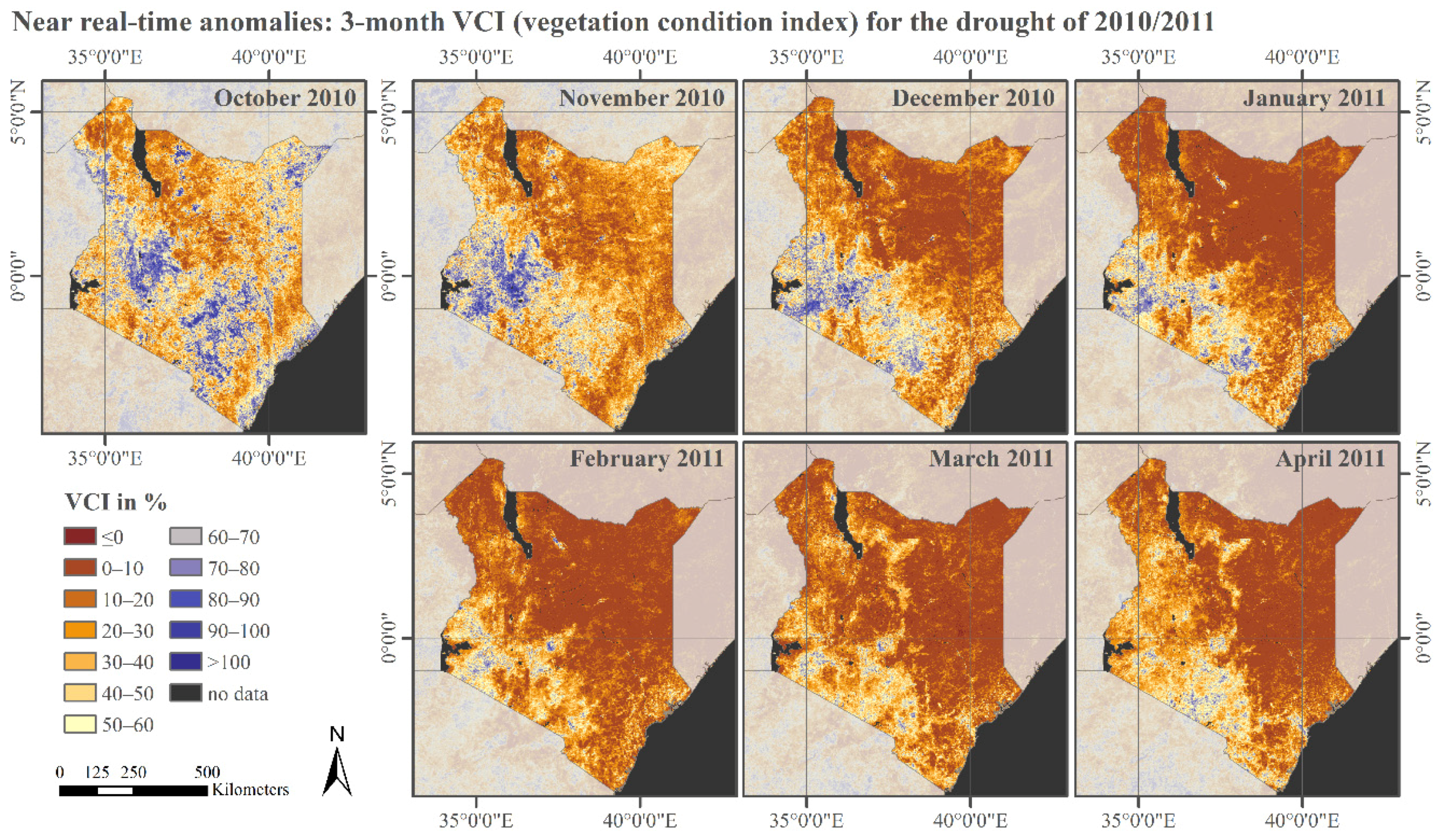
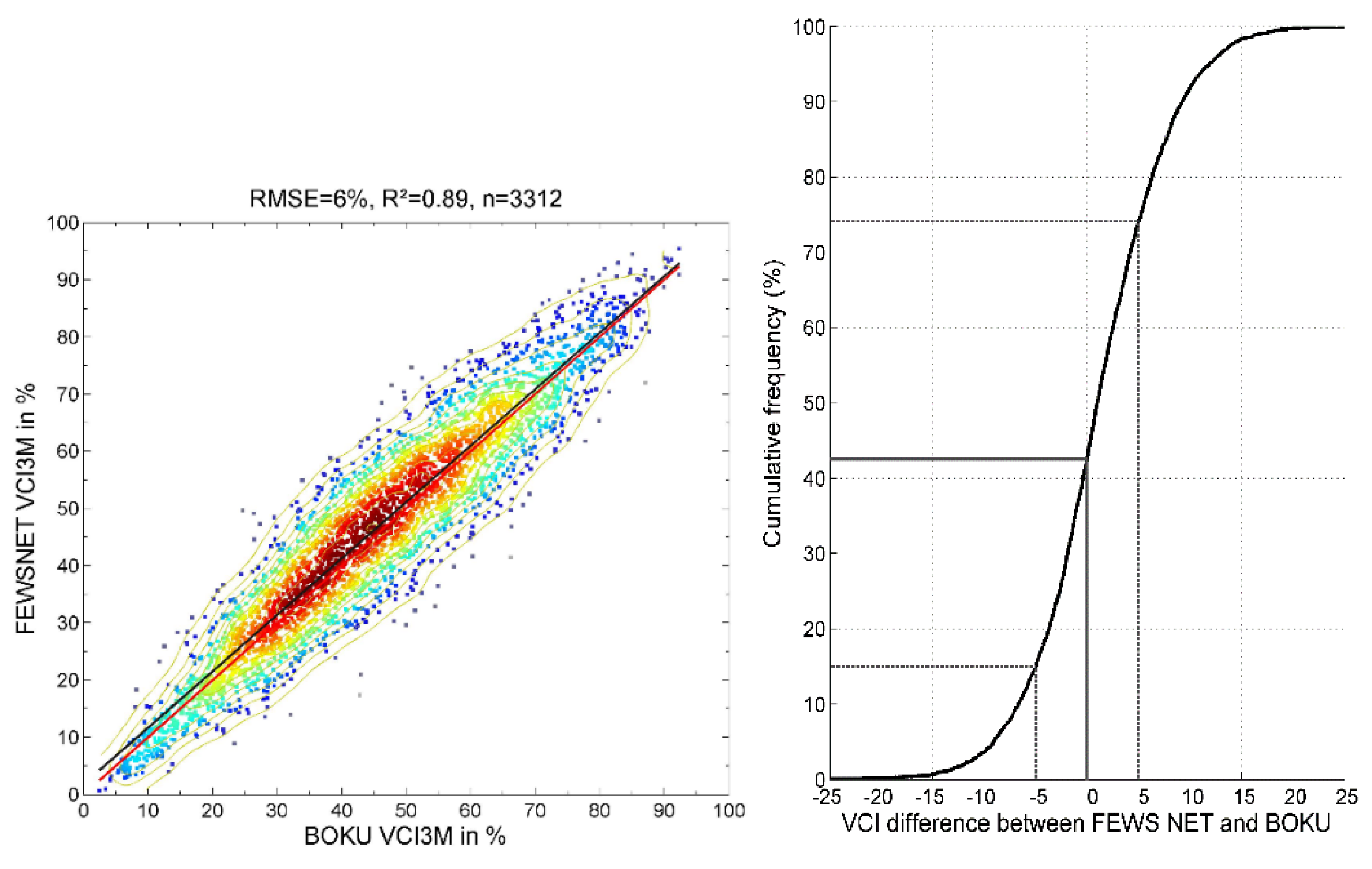
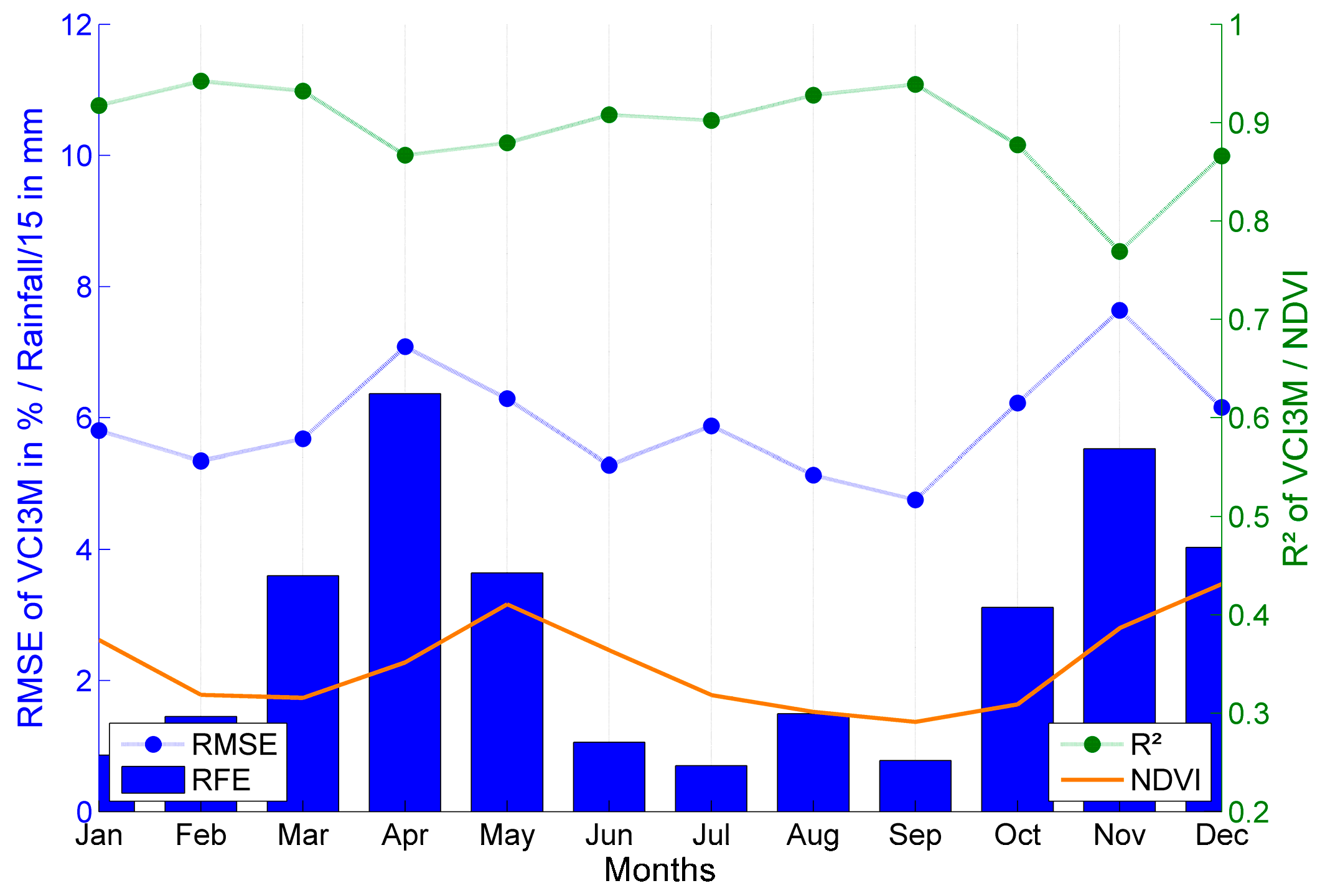


| MODIS QF | Description | Weight in Filtering |
|---|---|---|
| 1 | Very good | 1.0 |
| 2 | Good | 1.0 |
| 3 | Good | 1.0 |
| 4 | Acceptable | 0.8 |
| 5 | 0.6 | |
| 6 | 0.4 | |
| 7 | 0.2 | |
| 8 | Less reliable/unreliable | 0.0 |
| 9 | Less reliable/unreliable | 0.0 |
| Name | Description |
|---|---|
| Days to last measurement (NLM) | Number of days to last available measurement |
| Quality of last measurement (QLM) | MODIS VI quality of last available measurement |
| Number of measurements (NWM) | Number of valid measurements within the time window (175 days) |
| Quality of measurements (QWM) | Average MODIS VI quality of valid measurements within the time window (175 days) |
| Product | Updating Frequency | Temporal Aggregation Length | Spatial Aggregation/Product | ||||
|---|---|---|---|---|---|---|---|
| Pixel | Sub-County | County | |||||
| IMG | KMZ | QLK | CSV | CSV | |||
| NDVI | Weekly | Instantaneous | x | x | x | x | x |
| VCI1W | Weekly | Instantaneous | x | x | x | x | x |
| VCI1M | Monthly | 1 month | x | x | x | x | x |
| VCI3M | Monthly | 3 months | x | x | x | x | x |
| Europe | http://ivfl-info.boku.ac.at/index.php/eo-data-processing/real-time-modis-data-eu-only | ||||||
| Kenya | http://ivfl-geomap.boku.ac.at/demo_WG/kenya/ | ||||||
| Kenya | http://ivfl-info.boku.ac.at/index.php/eo-data-processing/data-analytics | ||||||
| VCI3M in % | Drought Category | Color |
|---|---|---|
| ≥50 | Wet | |
| 35 to 50 | No Drought/Normal | |
| 21 to 34 | Moderate Drought | |
| 10 to 20 | Severe Drought | |
| <10 | Extreme Drought |
© 2016 by the authors; licensee MDPI, Basel, Switzerland. This article is an open access article distributed under the terms and conditions of the Creative Commons by Attribution (CC-BY) license (http://creativecommons.org/licenses/by/4.0/).
Share and Cite
Klisch, A.; Atzberger, C. Operational Drought Monitoring in Kenya Using MODIS NDVI Time Series. Remote Sens. 2016, 8, 267. https://doi.org/10.3390/rs8040267
Klisch A, Atzberger C. Operational Drought Monitoring in Kenya Using MODIS NDVI Time Series. Remote Sensing. 2016; 8(4):267. https://doi.org/10.3390/rs8040267
Chicago/Turabian StyleKlisch, Anja, and Clement Atzberger. 2016. "Operational Drought Monitoring in Kenya Using MODIS NDVI Time Series" Remote Sensing 8, no. 4: 267. https://doi.org/10.3390/rs8040267






